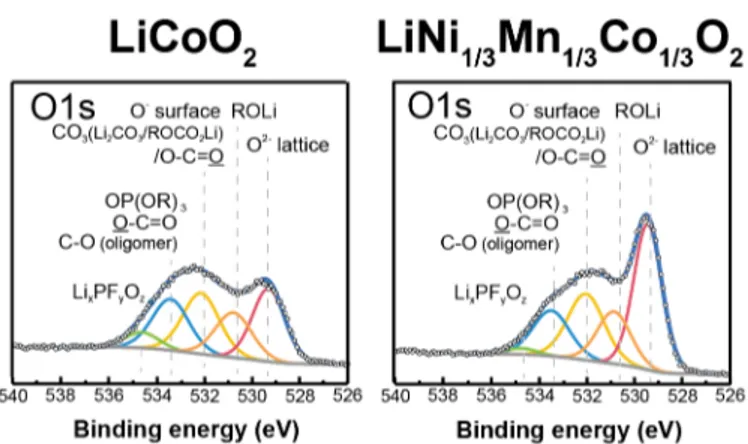HAL Id: cea-02349596
https://hal-cea.archives-ouvertes.fr/cea-02349596
Submitted on 5 Nov 2019HAL is a multi-disciplinary open access
archive for the deposit and dissemination of sci-entific research documents, whether they are pub-lished or not. The documents may come from teaching and research institutions in France or abroad, or from public or private research centers.
L’archive ouverte pluridisciplinaire HAL, est destinée au dépôt et à la diffusion de documents scientifiques de niveau recherche, publiés ou non, émanant des établissements d’enseignement et de recherche français ou étrangers, des laboratoires publics ou privés.
New insights into the electrode/electrolyte interface on
positive electrodes in Li-Ion batteries
Magali Gauthier, Pinar Karayaylali, Nir Pour, Simon Lux, Odysseas Paschos,
Filippo Maglia, Saskia Lupart, Peter Lamp, Livia Giordano, Yang Shao-Horn
To cite this version:
Magali Gauthier, Pinar Karayaylali, Nir Pour, Simon Lux, Odysseas Paschos, et al.. New insights into the electrode/electrolyte interface on positive electrodes in Li-Ion batteries. International Battery Association (IBA 2016), Mar 2016, Nantes, France. �cea-02349596�
NEW INSIGHTS INTO THE ELECTRODE/ELECTROLYTE
INTERFACE ON POSITIVE ELECTRODES IN LI-ION BATTERIES
Magali Gauthier,a Pinar Karayaylali,a Nir Pour,a Simon Lux,b Odysseas Paschos,b Filippo Maglia,b Saskia Lupart,b Peter Lamp,b Livia Giordanoa and Yang Shao-Horna
a Electrochemical Energy Laboratory, Massachusetts Institute of Technology, Cambridge, MA
02139 USA
b BMW AG, Petuelring 130, Munich 80788, Germany
mgauthie@mit.edu
Understanding and controlling the reactivity at the electrode/electrolyte interface (EEI) is one of the key issues for the development of high capacity and efficient lithium-ion batteries. The heterogeneous and partially catalytic reaction of the electrode with the electrolyte triggers the formation of surface films on the electrode surface which can cause degradation of the cell performance. Whereas the EEI layer properties are quite well known for negative electrodes such as lithium metal and graphite [1,2], the EEI layer on positive electrode materials is still puzzling. Especially the interface layers on high voltage and high capacity positive electrodes, whose potentials approach the limit of electrolyte stability against oxidation [3], is quite unexplored. One of the challenges in understanding the reactions at the surface of the electrode is the complicated composition of the positive electrodes, containing not only the active material but also conductive agents and polymeric binders, that can modify the EEI layers on the electrode. To bypass these ambiguities, there is a need for study model electrodes such as thin films or pure active material electrodes, which allow for investigating solely the reactivity of the electrolyte at the active material surface. Here, combining X-ray Photoelectron Spectroscopy (XPS and X-ray Absorption and Emission Spectroscopy (XAS/XES), of model electrodes, we will show how the species formed at the electrode/electrolyte interface are affected by change in charging potential and the structure and nature of the transition metal in the material. XES and XAS will be used to shed light on the change of electronic structure upon delithiation.
Figure 1: O1s XPS spectra photoemission lines for 100% LiCoO2 or LiNi1/3Mn1/3Co1/3O2 electrodes charged at 4.6 VLi at a rate of C/100 in 1M LiPF6 3:7 EC:EMC.
[1] Peled, E., J. Electrochem. Soc. 126, 2047–2051 (1979). [2] Aurbach, D. et al., J. Power Sources 81–82, 95–111 (1999). [3] Xu, K. et al., Chem. Rev., 114, 11503-11618 (2014).
